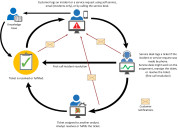Service Manager powered by HEAT
•About Using the Self-Service Portal
About Using the Self-Service Portal
The Self-Service Portal is used by requesters (end users, also called Self Service users) and service owners. This portal provides a simple interface and enables users to create, track, resolve, and close incidents and requests for service. Self Service users can also access FAQs, announcements, and knowledge articles. The Self-Service Portal is designed to be intuitive and easy to use.
A service request is a request for a service, such as transferring an employee. An issue (or incident) is an interruption of service.
The Self Service Lifecycle
When you submit an incident or a service request, the system logs it with the Service Desk, where a Service Desk Analyst begins processing it. You can use a Self Service dashboard to track the progress of or add more information to a service request. You can also communicate with a Service Desk Analyst while the incident or the service request is being worked on.
Self Service Lifecycle
Self Service Tasks
Self Service users logged in under other roles can also administer the Self-Service Portal ; approve or deny requests for changes; control which services are made available to other Self Service users; categorize services; and define the process by which these services are fulfilled. These activities typically can be performed only by users logged in as service owners.
The primary roles that use the Self-Service Portal are:
•Self Service users
•Service owners
Was this article useful?
The topic was:
Inaccurate
Incomplete
Not what I expected
Other
Copyright © 2017, Ivanti. All rights reserved.
